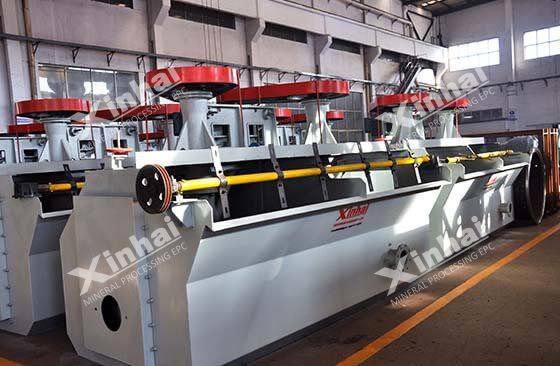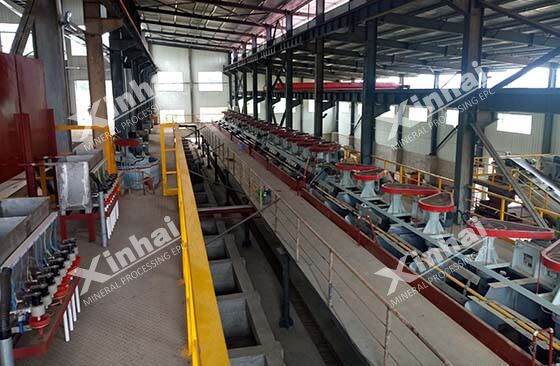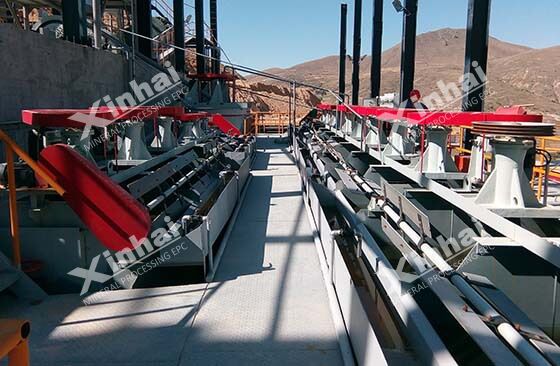The Common Barite Flotation Processing and Flotation Reagents
For the complex disseminated type of barite ore, the barite is often associated with fluorite, calcite, and quartz, which is difficult to be separated by the gravity separation method due to its low grade, fine disseminated grain size, and complex composition. The froth flotation method is the main barite processing method.

According to the type of salt-associated minerals, the barite ore can be divided into two categories: barite-quartz-calcite type ore and barite-fluorite type ore. Due to the similar surface chemical properties and similar flotation behavior between barite ore and associated salt minerals, the flotation process and the flotation reagents used in the different barite ores are different. Below, let’s take a look at the flotation process and reagents applied in the above two kinds of barite ore.
01 Flotation used in the barite-quartz-calcite type ore

According to the type of salt-associated minerals, the barite ore can be divided into two categories: barite-quartz-calcite type ore and barite-fluorite type ore. Due to the similar surface chemical properties and similar flotation behavior between barite ore and associated salt minerals, the flotation process and the flotation reagents used in the different barite ores are different. Below, let’s take a look at the flotation process and reagents applied in the above two kinds of barite ore.
01 Flotation used in the barite-quartz-calcite type ore
Direct flotation method
The flotations used in the barite-quartz-calcite type ore mainly include the following:
First, add the inhibitor to inhibit the gangue minerals (such as quartz, calcite). Then, add the anion collector under the weak alkaline condition. And the barite concentrate can be obtained by roughing and 3-5 times of concentrating.
In this process, the anionic collectors can adopt fatty acids, alkyl sulfates, petroleum sulfonates, and phosphonic acid collectors, among which the fatty acids are widely used as the barite flotation collectors, such as oleic acid, sodium oleate, naphthenic acid, oxidized paraffin soap, etc.

Flotation-gravity separation combined process
First, add the sodium silicate and collector to remove the quartz by flotation processing method. Then, adopt the gravity separation method to obtain the barite concentrate according to the density difference between gangue minerals and barite ore.
Since the quartz, calcite, and barite are belong to the calcium ion compounds with similar lattice and floatability, the single flotation reagents cannot reach the desired goal. Therefore, the combined flotation reagents are often used to achieve a better barite flotation effect.

02 Flotation used in the barite-fluorite type ore
The flotation used in the barite-fluorite type ore means to inhibit the gangue minerals (such as quartz), and obtain the barite-fluorite mixed concentrate through the bulk flotation, then separate the barite and fluorite by the flotation method. According to the flotation sequence of barite and fluorite, we can adopt the following two schemes: one is to inhibit the barite then float the fluorite; another is to inhibit the fluorite then float the barite.
Inhibit the barite then float the fluorite
This barite flotation processing means to obtain the mixed concentrate of barite-fluorite firstly by flotation, and then add the inhibitor to suppress barite and float the fluorite. This barite flotation processing can simultaneously recover the barite concentrate and fluorite concentrate with the high grade.
In the barite flotation processing, the barite inhibitors mainly include tannin extract, starch, dextrin, sodium lignin sulfonate and other polymerized carbohydrates, sodium silicate, sodium carbonate, sulfate, sodium hexametaphosphate, ferric (Fe3+) and aluminum (Al3 +) and other inorganic salts, as well as the combined inhibitors.

Inhibit the fluorite then float the barite
Add the inhibitors to suppress the fluorite in the mixed barite-fluorite concentrate, and obtain the barite concentrate through flotation processing. Then, add the fatty acid collectors and sodium silicate to the tailings, obtain the fluorite concentrate by several times (7-9 times) of concentrating. This barite flotation processing is featured with the simple flow and easy to operate, which can obtain the qualified barite concentrate, but the grade of fluorite concentrate is often not high, so it is suitable for the ore that only requires to recover the barite.
In this barite flotation processing, the common fluorite inhibitors include sodium silicate, sodium fluosilicate, citric acid, lignin, sodium hexametaphosphate, and starch.

At present, the flotation method has been widely used in the separation of barite ores with the low grade of barite ores and complicated ore properties. It is suggested to carry on the mineral processing test, comprehensively analyze the ore properties, make a scientific flotation process and follow a reasonable flotation reagent system according to the actual conditions of the barite processing plant and the investment budget, so as to obtain the ideal economic benefits and beneficiation indexes.
The flotations used in the barite-quartz-calcite type ore mainly include the following:
First, add the inhibitor to inhibit the gangue minerals (such as quartz, calcite). Then, add the anion collector under the weak alkaline condition. And the barite concentrate can be obtained by roughing and 3-5 times of concentrating.
In this process, the anionic collectors can adopt fatty acids, alkyl sulfates, petroleum sulfonates, and phosphonic acid collectors, among which the fatty acids are widely used as the barite flotation collectors, such as oleic acid, sodium oleate, naphthenic acid, oxidized paraffin soap, etc.

Flotation-gravity separation combined process
First, add the sodium silicate and collector to remove the quartz by flotation processing method. Then, adopt the gravity separation method to obtain the barite concentrate according to the density difference between gangue minerals and barite ore.
Since the quartz, calcite, and barite are belong to the calcium ion compounds with similar lattice and floatability, the single flotation reagents cannot reach the desired goal. Therefore, the combined flotation reagents are often used to achieve a better barite flotation effect.

02 Flotation used in the barite-fluorite type ore
The flotation used in the barite-fluorite type ore means to inhibit the gangue minerals (such as quartz), and obtain the barite-fluorite mixed concentrate through the bulk flotation, then separate the barite and fluorite by the flotation method. According to the flotation sequence of barite and fluorite, we can adopt the following two schemes: one is to inhibit the barite then float the fluorite; another is to inhibit the fluorite then float the barite.
Inhibit the barite then float the fluorite
This barite flotation processing means to obtain the mixed concentrate of barite-fluorite firstly by flotation, and then add the inhibitor to suppress barite and float the fluorite. This barite flotation processing can simultaneously recover the barite concentrate and fluorite concentrate with the high grade.
In the barite flotation processing, the barite inhibitors mainly include tannin extract, starch, dextrin, sodium lignin sulfonate and other polymerized carbohydrates, sodium silicate, sodium carbonate, sulfate, sodium hexametaphosphate, ferric (Fe3+) and aluminum (Al3 +) and other inorganic salts, as well as the combined inhibitors.

Inhibit the fluorite then float the barite
Add the inhibitors to suppress the fluorite in the mixed barite-fluorite concentrate, and obtain the barite concentrate through flotation processing. Then, add the fatty acid collectors and sodium silicate to the tailings, obtain the fluorite concentrate by several times (7-9 times) of concentrating. This barite flotation processing is featured with the simple flow and easy to operate, which can obtain the qualified barite concentrate, but the grade of fluorite concentrate is often not high, so it is suitable for the ore that only requires to recover the barite.
In this barite flotation processing, the common fluorite inhibitors include sodium silicate, sodium fluosilicate, citric acid, lignin, sodium hexametaphosphate, and starch.

At present, the flotation method has been widely used in the separation of barite ores with the low grade of barite ores and complicated ore properties. It is suggested to carry on the mineral processing test, comprehensively analyze the ore properties, make a scientific flotation process and follow a reasonable flotation reagent system according to the actual conditions of the barite processing plant and the investment budget, so as to obtain the ideal economic benefits and beneficiation indexes.


评论
发表评论